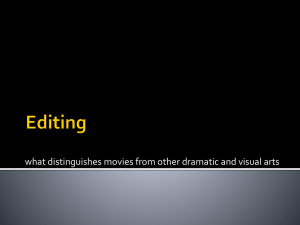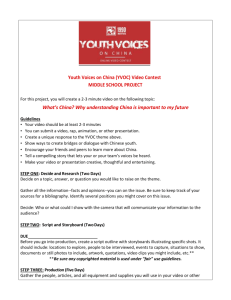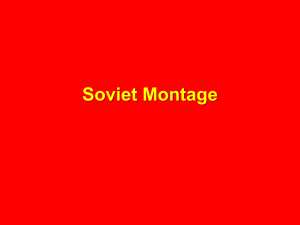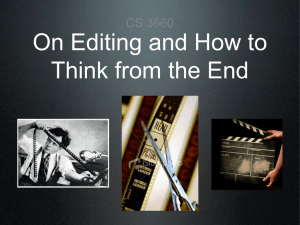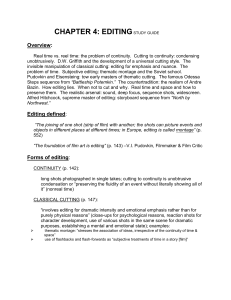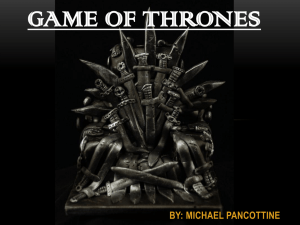The Three Citation Formats
advertisement
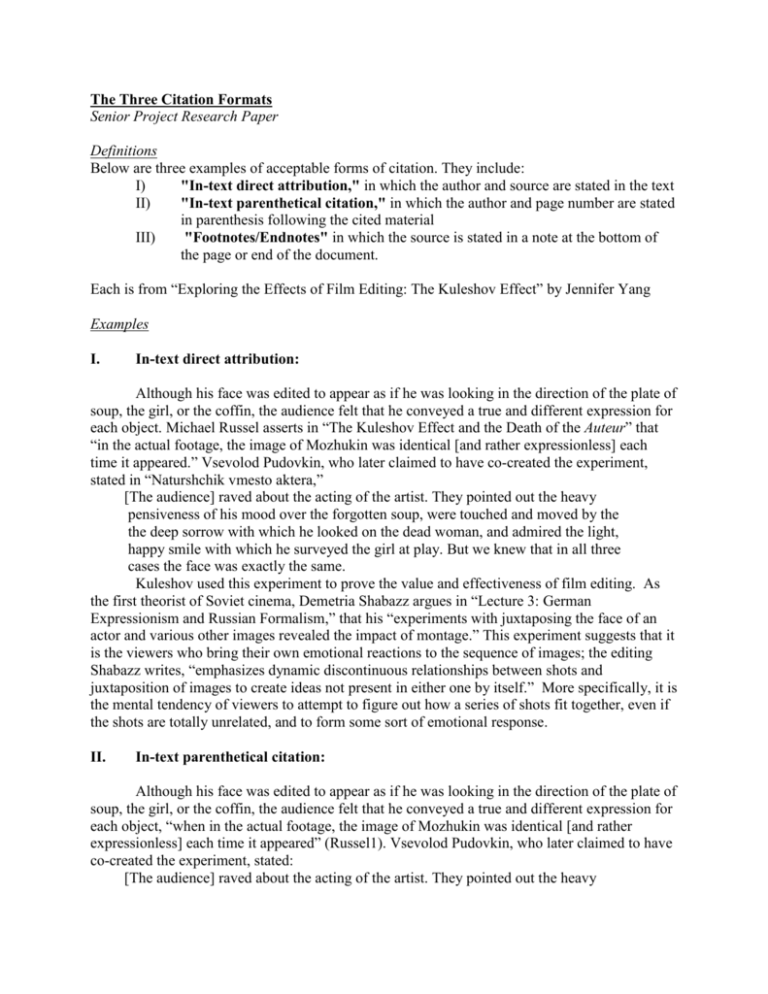
The Three Citation Formats Senior Project Research Paper Definitions Below are three examples of acceptable forms of citation. They include: I) "In-text direct attribution," in which the author and source are stated in the text II) "In-text parenthetical citation," in which the author and page number are stated in parenthesis following the cited material III) "Footnotes/Endnotes" in which the source is stated in a note at the bottom of the page or end of the document. Each is from “Exploring the Effects of Film Editing: The Kuleshov Effect” by Jennifer Yang Examples I. In-text direct attribution: Although his face was edited to appear as if he was looking in the direction of the plate of soup, the girl, or the coffin, the audience felt that he conveyed a true and different expression for each object. Michael Russel asserts in “The Kuleshov Effect and the Death of the Auteur” that “in the actual footage, the image of Mozhukin was identical [and rather expressionless] each time it appeared.” Vsevolod Pudovkin, who later claimed to have co-created the experiment, stated in “Naturshchik vmesto aktera,” [The audience] raved about the acting of the artist. They pointed out the heavy pensiveness of his mood over the forgotten soup, were touched and moved by the the deep sorrow with which he looked on the dead woman, and admired the light, happy smile with which he surveyed the girl at play. But we knew that in all three cases the face was exactly the same. Kuleshov used this experiment to prove the value and effectiveness of film editing. As the first theorist of Soviet cinema, Demetria Shabazz argues in “Lecture 3: German Expressionism and Russian Formalism,” that his “experiments with juxtaposing the face of an actor and various other images revealed the impact of montage.” This experiment suggests that it is the viewers who bring their own emotional reactions to the sequence of images; the editing Shabazz writes, “emphasizes dynamic discontinuous relationships between shots and juxtaposition of images to create ideas not present in either one by itself.” More specifically, it is the mental tendency of viewers to attempt to figure out how a series of shots fit together, even if the shots are totally unrelated, and to form some sort of emotional response. II. In-text parenthetical citation: Although his face was edited to appear as if he was looking in the direction of the plate of soup, the girl, or the coffin, the audience felt that he conveyed a true and different expression for each object, “when in the actual footage, the image of Mozhukin was identical [and rather expressionless] each time it appeared” (Russel1). Vsevolod Pudovkin, who later claimed to have co-created the experiment, stated: [The audience] raved about the acting of the artist. They pointed out the heavy pensiveness of his mood over the forgotten soup, were touched and moved by the the deep sorrow with which he looked on the dead woman, and admired the light, happy smile with which he surveyed the girl at play. But we knew that in all three cases the face was exactly the same (Pudovkin 184). Kuleshov used this experiment to prove the value and effectiveness of film editing. As the first theorist of Soviet cinema, his “experiments with juxtaposing the face of an actor and various other images revealed the impact of montage” (Shabazz 4). This experiment suggests that it is the viewers who bring their own emotional reactions to the sequence of images; the editing “emphasizes dynamic discontinuous relationships between shots and juxtaposition of images to create ideas not present in either one by itself” (Shabazz 5). More specifically, it is the mental tendency of viewers to attempt to figure out how a series of shots fit together, even if the shots are totally unrelated, and to form some sort of emotional response. III. Footnotes/Endnotes, Example: Although his face was edited to appear as if he was looking in the direction of the plate of soup, the girl, or the coffin, the audience felt that he conveyed a true and different expression for each object, that “when in the actual footage, the image of Mozhukin was identical [and rather expressionless] each time it appeared.”1 Vsevolod Pudovkin, who later claimed to have cocreated the experiment, stated: [The audience] raved about the acting of the artist. They pointed out the heavy pensiveness of his mood over the forgotten soup, were touched and moved by the the deep sorrow with which he looked on the dead woman, and admired the light, happy smile with which he surveyed the girl at play. But we knew that in all three cases the face was exactly the same.2 Kuleshov used this experiment to prove the value and effectiveness of film editing. As the first theorist of Soviet cinema, Shabazz argues that his “experiments with juxtaposing the face of an actor and various other images revealed the impact of montage.”3 This experiment suggests that it is the viewers who bring their own emotional reactions to the sequence of images; the editing, Shabazz writes, “emphasizes dynamic discontinuous relationships between shots and juxtaposition of images to create ideas not present in either one by itself.”4 More specifically, it is the mental tendency of viewers to attempt to figure out how a series of shots fit together, even if the shots are totally unrelated, and to form some sort of emotional response. 1 2 3 4 Michael Russel, “The Kuleshov Effect and the Death of the Auteur.” Vsevolod Pudovkin, “Naturshchik vmesto aktera,” 184. Demetria Shabazz, “Lecture 3: German Expressionism and Russian Formalism,” 4. Ibid. 5. The footnote/endnote form is different from a bibliographical entry: Footnotes: 1 First Name Last Name, Title, (Publisher and date) Page. (Note that there are commas rather than periods separating author, title, publisher. The entry ends with a period.) Other details: 1) Ibid. (Latin) is used instead of repeating the previous reference. 1 Lashley, C. (1995) Improving study skills. A competence approach. London, Cassell. 2 Ibid. 155. 3 Ibid. 170. 2) Op.Cit. (Latin) is used after an author’s name to mean the same work as last cited for this author. 1 . Bennett, C. (1996) Researching into teaching methods in colleges & universities. London, Kogan Page. 2. Manger, J.J (1995). The essential internet information guide. New York, McGraw Hill. 3. Bennett, C. op.cit. 175.



